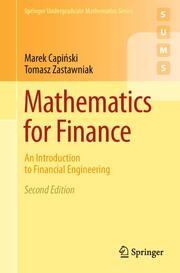-
Zusatztext
-
Mathematics for Finance: An Introduction to Financial Engineering combines financial motivation with mathematical style. Assuming only basic knowledge of probability and calculus, it presents three major areas of mathematical finance, namely Option pricing based on the no-arbitrage principle in discrete and continuous time setting, Markowitz portfolio optimisation and Capital Asset Pricing Model, and basic stochastic interest rate models in discrete setting.
-
-
Kurztext
-
As with the first edition, Mathematics for Finance: An Introduction to Financial Engineering combines financial motivation with mathematical style. Assuming only basic knowledge of probability and calculus, it presents three major areas of mathematical finance, namely option pricing based on the no-arbitrage principle in discrete and continuous time setting, Markowitz portfolio optimisation and the Capital Asset Pricing Model, and basic stochastic interest rate models in discrete setting.In this second edition, the material has been thoroughly revised and rearranged. New features include:- A case study to begin each chapter - a real-life situation motivating the development of theoretical tools;- A detailed discussion of the case study at the end of each chapter;- A new chapter on time-continuous models with intuitive outlines of the mathematical arguments and constructions;- Complete proofs of the two fundamental theorems of mathematical finance in discrete setting.From the reviews of the first edition:"This text is an excellent introduction to Mathematical Finance. Armed with a knowledge of basic calculus and probability a student can use this book to learn about derivatives, interest rates and their term structure and portfolio management."(Zentralblatt MATH)"Given these basic tools, it is surprising how high a level of sophistication the authors achieve, covering such topics as arbitrage-free valuation, binomial trees, and risk-neutral valuation." (www.riskbook.com)"The reviewer can only congratulate the authors with successful completion of a difficult task of writing a useful textbook on a traditionally hard topic." (K. Borovkov, The Australian Mathematical Society Gazette, Vol. 31 (4), 2004)
-
-
Autorenportrait
- Marek Capinski is Professor of Mathematics at AGH University of Science and Technology, Poland. Tomasz Zastawniak is Professor of Mathematics at the University of York, UK.
Detailansicht
Mathematics for Finance
An Introduction to Financial Engineering, Springer Undergraduate Mathematics Series
ISBN/EAN: 9780857290816
Umbreit-Nr.: 634039
Sprache:
Englisch
Umfang: xiii, 336 S., 66 s/w Illustr., 336 p. 66 illus.
Format in cm: 1.9 x 23.4 x 15.5
Einband:
kartoniertes Buch
Erschienen am 25.11.2010
Auflage: 2/2011


